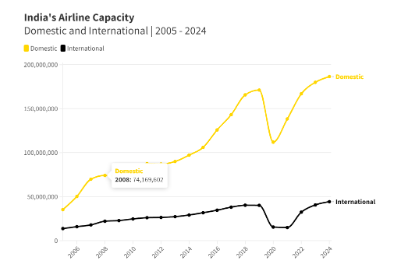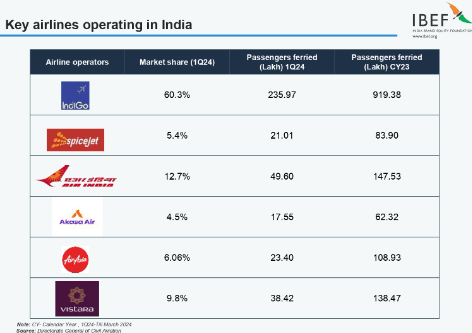The year 2003 marked a significant milestone for Indian aviation, as low-cost carrier Air Deccan, founded by Captain Gopinath, revolutionised domestic travel. Eleven years later, flying has become an accessible and affordable option for the middle class, making air travel a popular choice for domestic destinations. Since then, the Indian aviation industry has come a long way. As per the latest reports India has surpassed Brazil and Indonesia to become the third largest domestic aviation market in the world.
Join us as we explore the aviation industry’s growth. “The People Weekly”, an endeavour by PeopleLogic provides valuable industry insights and analysis to empower you to make informed decisions.
Indian Aviation Industry – The Success Story
The Indian aviation industry has faced several challenges over the years. The year 2012 was one of the most turbulent years for the industry with Kingfisher airlines being grounded, financial woes for Air India and several other carriers and a mega airport airport upgrade project bagged by an Indian infra firm terminated by the Maldives government. The covid wave, economic downturns, fuel price fluctuations, and geopolitical events have all impacted the sector. Additionally, issues such as infrastructure bottlenecks, regulatory hurdles, and competition from other modes of transportation have posed significant challenges.
Despite facing challenges, the Indian aviation industry has successfully navigated obstacles and is now on a positive trajectory. The government’s support, including airport modernization and favourable policies, has created a conducive environment for growth.
Growth of Indian Aviation Industry
The Indian commercial aviation industry can be further divided into passenger and cargo sectors. A report by Boeing has observed that India will lead South East Asia’s commercial aviation growth.
As per a study, the Indian air freight (cargo) sector which is now at $14 Bn is poised to grow at a CAGR of 5.535 to reach $17.22 billion by 2028. At the same time the global freight market which is valued at USD 257.44 billion in 2023 and is expected to grow at a CAGR of 10.3% from 2024 to 2030.
As per IBEF, From FY16 to FY24, domestic freight traffic increased at a CAGR of 3% and international freight traffic increased at a CAGR of 2.7%. In FY24, domestic freight traffic stood at 1.32 MMT and international freight traffic was 2.04 MMT. During April-March 2024, domestic freight traffic was 1320 thousand tonnes and international freight traffic was 2046 thousand tonnes.
Talking about the civil aviation of the passenger sector in commercial aviation industry, an OAG report has observed the airline capacity in India will reach 230m departing seats in 2024, which is double the number that was in 2014. An interesting observation here is that

the domestic capacity has grown faster than the international capacity at 8.7% annually.
At the same time, the global aviation market will witness a CAGR of 4.43% and will reach As per CRISIL prediction, Indian airlines will have 50% market share in international passenger traffic by FY28.
In fact the Indian aviation industry has recovered fully from the covid shock and if the reports are to be believed is on an upward trajectory. In fact, the Indian air traffic movement stood at 327.28 million in FY23 compared to 188.89 million in FY22. Now pegged at the 3rd position, the Indian civil aviation sector is expected to overtake China and the US by 2030, as per IATA. The number of passenger aeroplanes will reach 1100 by 2027.
The H1 of FY’25 was a great year for the industry with 7.93 crore passengers compared to 7.6 passengers during the same period last year. The economic survey 2023-24 has observed that the Indian civil aviation sector will see an unprecedented growth with a projected demand of 2200 aircrafts by 2040.
Factors contributing to the growth of Indian aviation industry are
Rising disposable incomes: The overall economic growth of India has contributed to the growing middle class in India thus increasing the demand for air travel as people have more disposable income to spend on travel. The rapid urbanisation of India has also led to increased business travel and tourism, boosting demand for air travel.
Government initiatives: The Indian government has played a crucial role in supporting the growth of the aviation industry through initiatives such as airport modernization, expansion of air traffic control infrastructure, and favourable policies.
Low-cost carriers: The entry of low-cost carriers has made air travel more affordable and accessible to a wider segment of the population.
Improved infrastructure: Investments in airport infrastructure and air traffic control systems have enhanced the efficiency and capacity of the Indian aviation sector. The growing private sector participation (PPP model) in building and developing airports has contributed to the growth of the aviation industry.
Technological advancements: Advancements in aviation technology, such as fuel-efficient aircraft and improved navigation systems, have contributed to the growth of the industry.
Increased FDI Flow: Up to 100% FDI in civil aviation, MRO, and ground handling services is one of the major contributing factors to the growth of the Indian aviation industry. There is an increase in private participation oi the development of model
Major players in Indian aviation industry
As of 2024, there are around 39 airline operators in India scheduled, regional, chartered, and cargo airlines. Some of the key airlines operating in India are,

As for cargo airline operators, some of the key players are
- Blue Dart Aviation
- Pradhaan Air Express
- Quikjet Airlines
- SpiceXpress
- Indigo CarGO
Job Creation
The aviation industry remains a significant contributor to India’s economy, accounting for 5% of the national GDP. As of today, the industry employs nearly 2 million people, providing a wide range of skilled and unskilled jobs. A single flight to a new airport can create 31 direct jobs and 100+ jobs across the aviation spectrum and for every virgin route around 140- 240 jobs are created. Studies conducted by ICAO and NACER show that for the aviation industry the employment multiplier is 5X – 7X.
If the current trends continue, the Indian aviation industry will create 9.1 million jobs by 2037.

From pilots and cabin crew to ground staff and engineers, the aviation industry offers a wide range of jobs. Support services like catering, ground handling, and maintenance also create employment opportunities.
As the aviation industry grows, the demand for skilled workers will grow. While the Indian government is taking all efforts to improve the number of licensed pilots in the country, it is estimated that the country needs around 11,000 more pilots by the end of 2029-2030 not to mention leadership talent like CEO, COOs to run the airlines. There is also a huge demand for AMEs i.e aircraft maintenance engineers are several airlines looking to add to their fleet.
PeopleLogic Opinion
The Indian aviation industry has witnessed a remarkable journey, marked by significant growth and transformation. The entry of low-cost carriers, coupled with government support and infrastructure development, has made air travel more accessible to a wider segment of the population. While challenges such as fuel costs and competition persist, the industry’s future outlook remains promising.
This rapid growth of the Indian aviation industry has increased the demand for skilled professionals. As a leading recruitment firm with deep expertise in the aviation sector, PeopleLogic is uniquely positioned to help you find the top talent your organisation’s needs. Our team leverages extensive networks and industry knowledge to source and select qualified candidates across various roles, from operations to management. Let us help you build a high-performing team and drive your organisation’s success.






